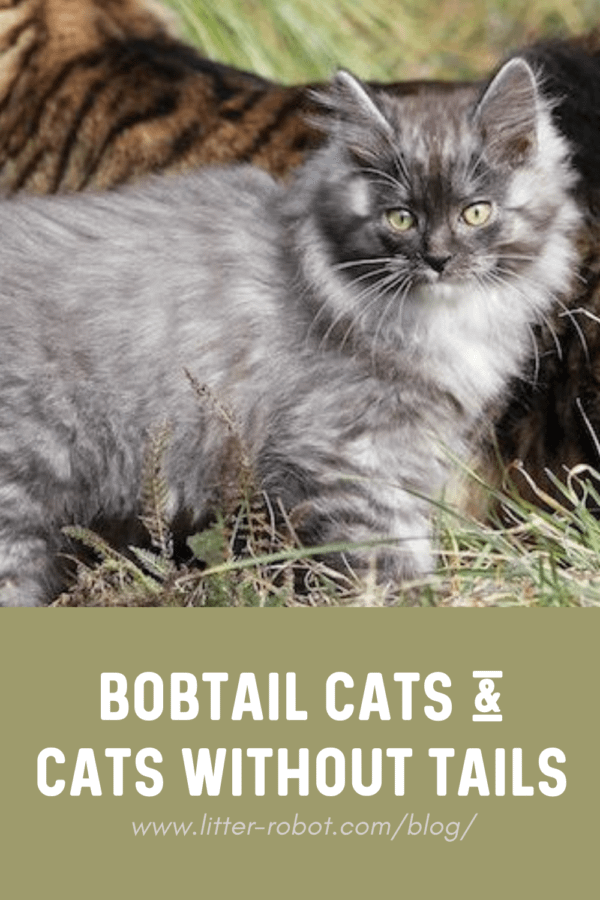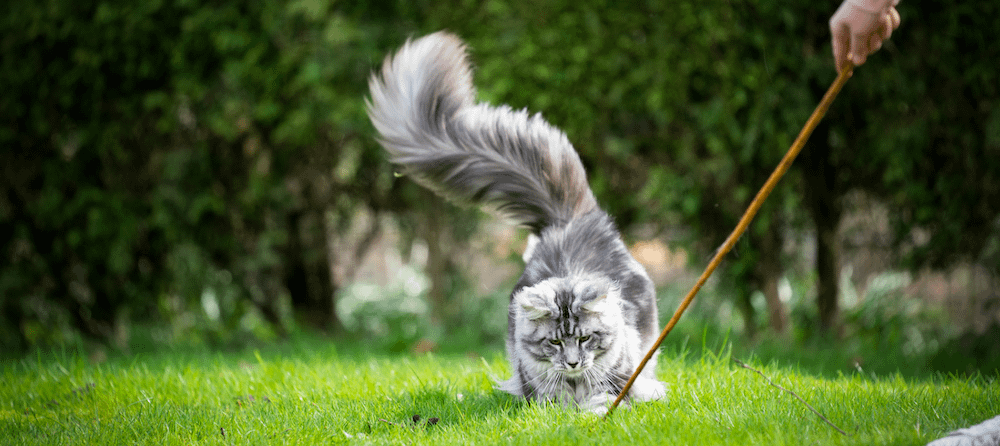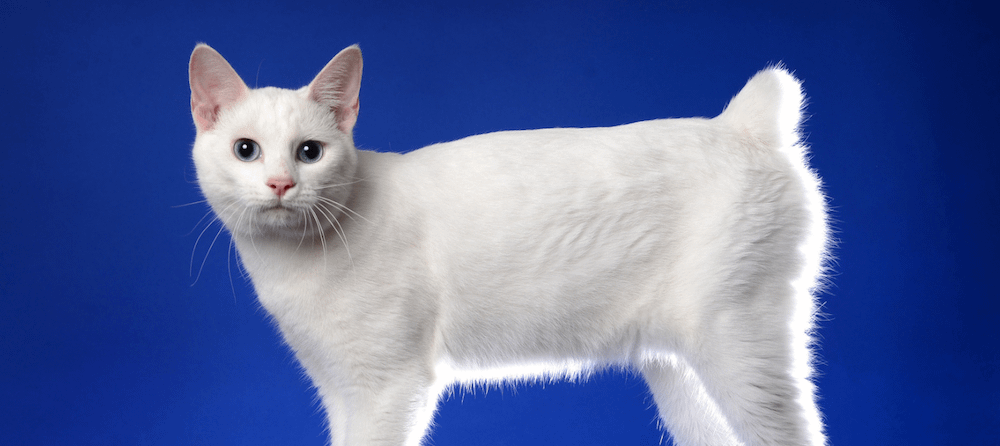Updated April 9, 2024
We’re all about cats with unique tails. Have you ever seen a cat with a bobtail? At first glance you may have thought it was a wild bobcat! Surprisingly, there are quite a few different breeds of bobtail cats, and even a few cats without tails. Learn more about cats with these mutations, as well as which breeds you’ll commonly find them on.
What is a bobtail cat?
And where do they come from? Bobtails are a naturally occurring genetic mutation found among certain cat breeds. This mutation results in a shorter tail, giving these cats their charming "bobbed" look. Originating from different corners of the world, from North America to Asia, bobtail cats have a diverse and intriguing history.
Fortunately, bobtails generally don’t impact a cat’s way of life. Some bobtail cats do suffer arthritis of the tailbone. In some cases, the bobtail mutation can cause health issues with the cat's digestive and urinary systems resulting in constipation, urinary tract infections, and issues with bowel control. Bobtail cat owners will need to regularly monitor their feline friend and it might require specialized treatments by a veterinarian.
While we’ve learned that tails play an important role in certain aspects of your cat’s life—including the ability to balance, righting reflex, and sensory touch—these bobtail cat breeds seem to get along just fine with extra short tails! Despite the potential health problems mentioned above, bobtail cats tend to have a robust lifespan. For instance, the American Bobtail typically lives between 11 and 15 years, while the Japanese Bobtail can live 15 to 20 years, given proper care and nutrition.
Personality
Bobtails are well known for their friendly and adaptable personalities. For instance, the American Bobtail cat, sometimes referred to as the Golden Retriever of the cat world, is known for their laid-back temperament and adaptability to different environments. Despite their somewhat wild appearance, they are known to form strong bonds and get along great with kids and other pets, making them an excellent choice for families.
On the other hand, the Japanese Bobtail is a social butterfly that loves to follow their human companions around and chirp for attention. These cats are curious and intelligent, often showing a playful side well into their adult years. They're also known for their vocal nature, communicating with their family through soft chirps and meows. This breed is particularly known for their love of games, showing a surprising ability to learn tricks and solve puzzles.
Despite their diverse personalities, most bobtail cats share a common trait of being loyal and affectionate towards their human families. Whether they're curling up on your lap for a nap or following you around the house, their love and loyalty are apparent.
Activity requirements
Cats of all tail types can have a wide spectrum of activity requirements. Bobtail cats are the same, as different breeds have different preferences when it comes to activity.
American Bobtails, for example, love to play and walk on a leash but aren't overly active pets. Despite their laid-back demeanor, they do enjoy interactive play and can be quite agile. They have a knack for games that test their mental and physical abilities. Fetch, hide and seek, and puzzle toys are all great options for these intelligent felines. They require a moderate amount of exercise before they're ready to settle down for a nap.
Japanese Bobtails, on the other hand, are more playful and require more stimulation to keep them happy and healthy. This breed is known for their high energy levels and curiosity. They love exploring their surroundings and can often be found climbing on cat trees or chasing after toys. An environment that offers plenty of opportunities for climbing, scratching, and playing is ideal for a Japanese Bobtail. Regular play sessions and access to toys and scratching posts can help keep a bobtail cat mentally and physically stimulated.
7 of our favorite bobtail cats
There is more than just one bobtail breed of cat. Here is a list of seven short-tailed cats that we think might be the perfect fit for you:
American Bobtail
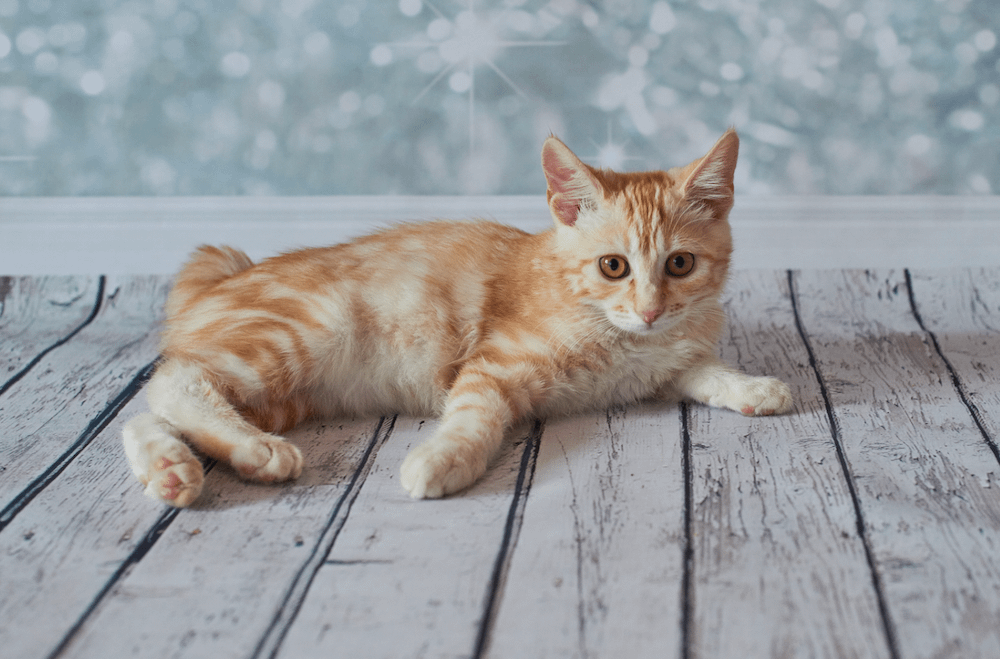
The American Bobtail, sometimes referred to as the Golden Retriever of the cat world, is a breed that emerged in the 1960s from feral cats with natural bobtails. Two breeders, John and Brenda Sanders, found a bobbed-tail cat at an Arizona motel and brought him to their home in Iowa. They then bred the bobtail with their female seal-point Siamese cat, leading to a litter of bobtail kittens with sweet temperaments. Through more selective breeding, the American Bobtail’s “wild” markings, shortened tails, and compact bodies became preferred by breeders.
These cats are adaptable and laid-back. As much as they love to play, walk on a leash, and travel, they aren’t overly active pets and only need so much before they retire to a nice, warm nap.
Japanese Bobtail
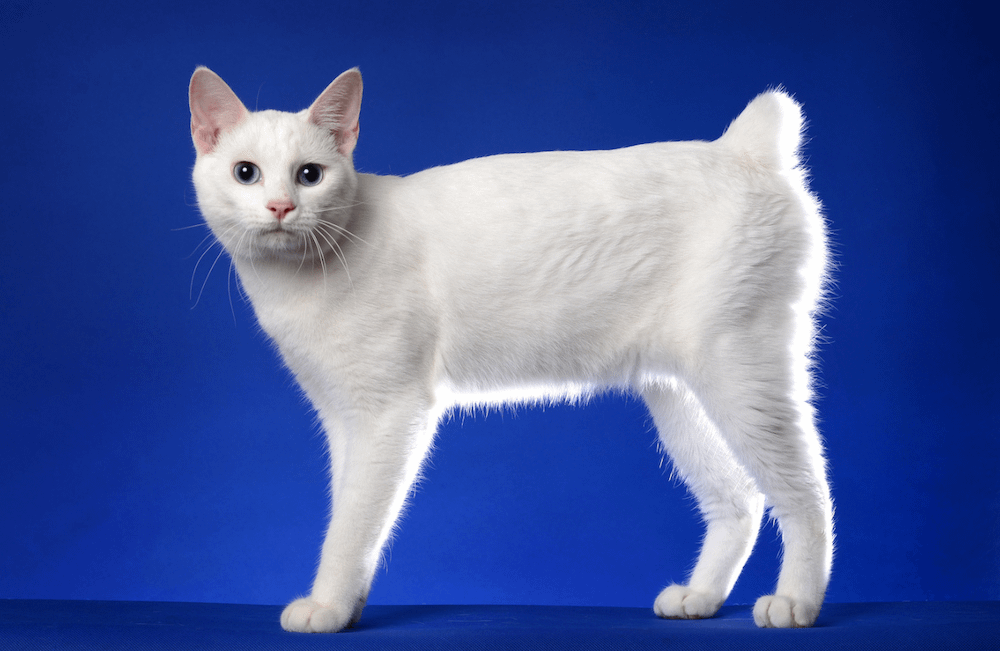
The Japanese Bobtail has a short “bunny tail” that can be rigid or flexible. This breed has likely been around for at least 1,000 years, though they were first recorded in the early 1600s when they were released into the streets of Japan to help maintain the rat population that was infiltrating silkworm farms. The first Japanese Bobtail was imported to the U.S. in 1968.
Their tailbone is no longer than three inches from the body and should be clearly visible, according to the breed standard. No two tails are alike: They can vary in size, tufts, kinks, and curls.
Japanese Bobtails are happy, social cats that will follow their humans around, interrupt their business, and chirp when they are looking for attention.
Highlander
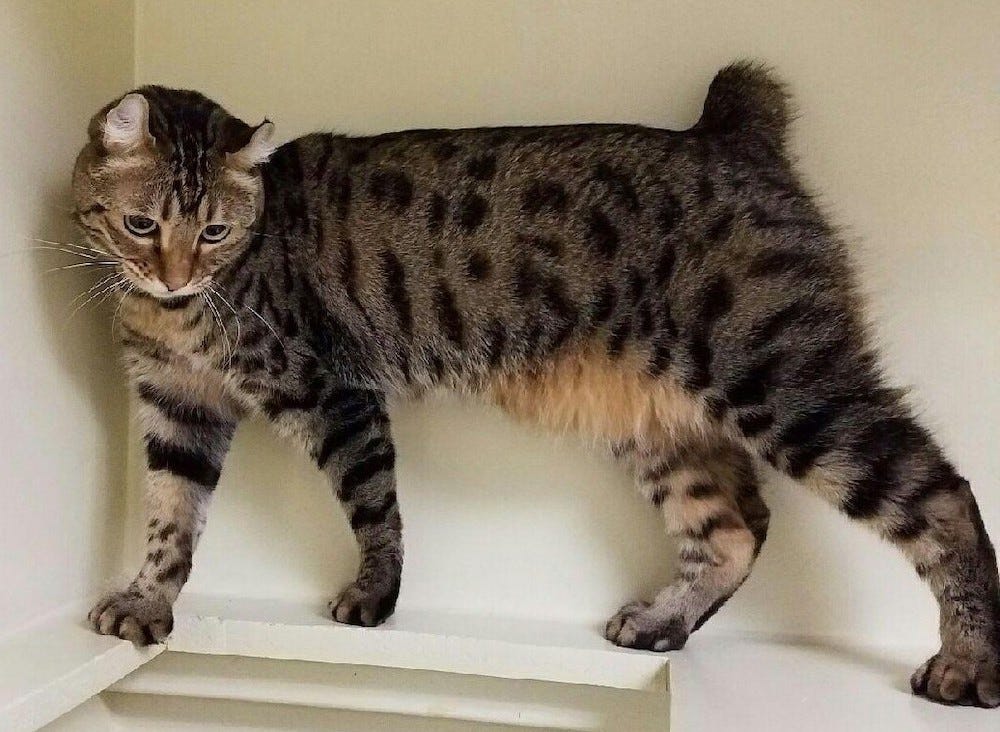
The unique Highlander cat breed's bobbed tails make them seem smaller than they actually are, but their often lengthy coats make up for it. This cat originated as a crossbreed of the experimental Desert Lynx bobtail cats—from which they received their short tail and exotic spots—and the Jungle Curl, from which they got their distinct curled ears. They are still not recognized by major cat registries, but they are with the Rare and Exotic Feline Registry.
Despite their wild looks, Highlander cats are incredibly playful and outgoing. They love being around their humans and enjoy meeting new people.
Pixie-bob

Of all the bobtail cats on our list, the brawny Pixie-bob might look like the closest relative to a wild bobcat. Legends abound, including that they originated from wild North American bobcats. However, much like the American Bobtail, the Pixie-bob is just a domestic cat with a tail mutation. Specifically, they were bred in the 1980s to resemble wild red bobcats found in the coastal mountains of Washington state.
These cats can grow large and are often polydactyl. They typically display brown tabby coat patterns, sometimes appearing reddish, and their fur can be short or long. They are dog-like in personality, learning to play fetch or walk on a leash.
Kurilian Bobtail
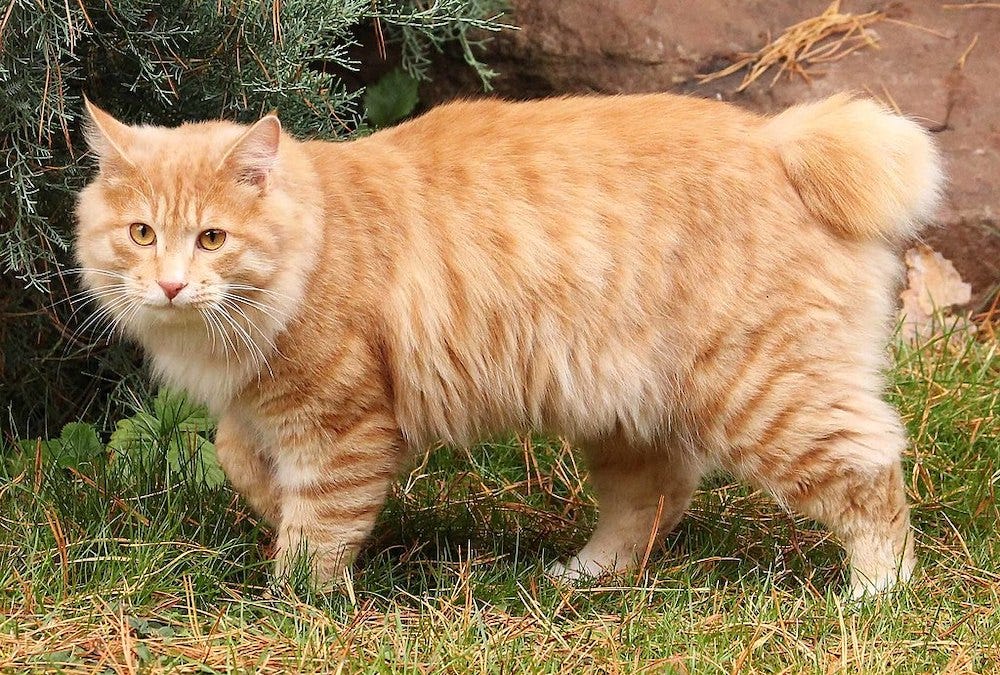
The lynx-like Kurilian Bobtail is a natural breed found on Russia’s Sakhalin island and Kuril archipelago. Cats with short tails have been documented on the islands for at least 200 years, and were brought to central Russia in the mid-20th century. Their “pom” tails complement their strong, cobby bodies and lush, semi-long coat.
The Kurilian Bobtail is well-known for their mousing abilities, but they’re much more than that. They are loving, gentle cats that will just as happily crawl into their human’s lap as chase down vermin. They even enjoy playing in water.
Mekong Bobtail
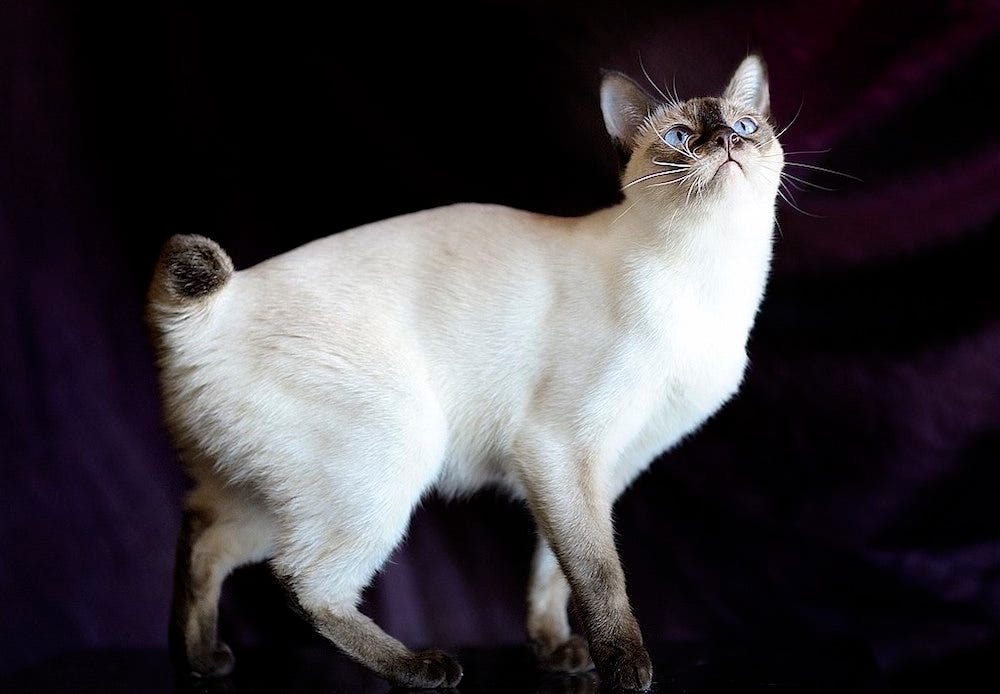
With a distinct kinked tail, the small, affectionate Mekong Bobtail is naturally found throughout many parts of Southeast Asia. In the latter part of the 19th century, some 200 cats, considered “royal,” were gifted to Nicholas II, the Tsar of Russia, by the King of Siam (modern-day Thailand). This eventually led to the development of the Toybob (more on that below!) in Russia.
The Mekong Bobtail looks like a Siamese cat with a bobbed tail. This breed is highly affectionate and playful, and loves children and strangers alike. They’re most enamored by their human family members, and spend as much as possible nearby.
Toybob
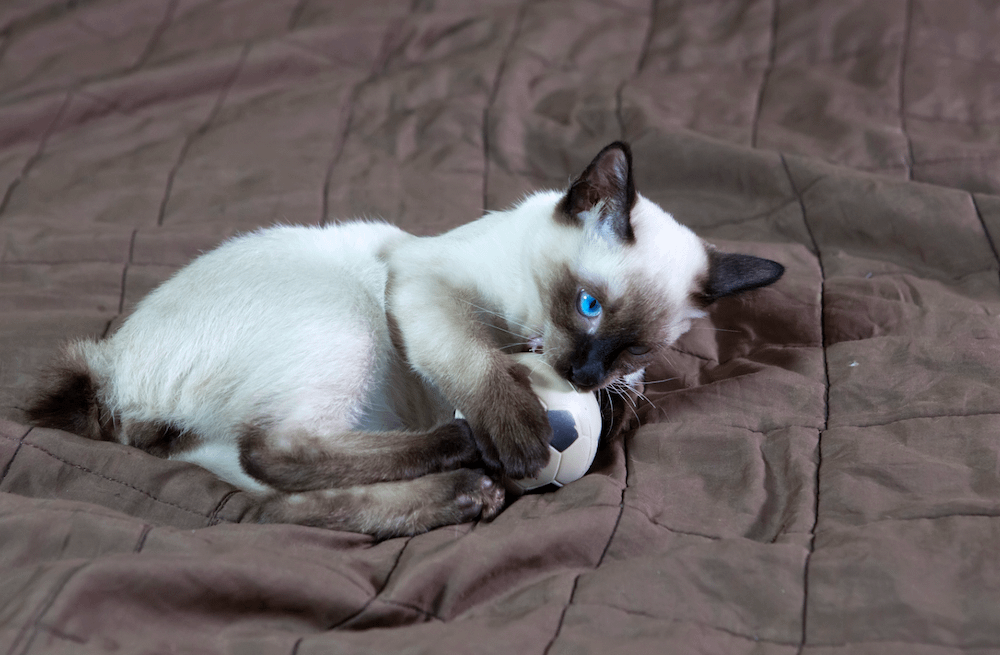
Perpetually kittens in size, the Toybob breed appeared after a Mekong Bobtail breeder bred a stray seal-point male with a kinked bobbed tail and a short-tailed seal-point female. This produced unusually tiny bobtail kittens: These cats weigh on average between 3 and 7 pounds! Forever kittens, indeed.
These playful, cuddly companions are content to be with their humans. They are a bit shy with strangers, but warm up with time. Toybobs are affectionate, devoted cats with hearts that are seemingly bigger than their bodies.
Cats without tails
A cat with no tail is unusual, to say the least. There are two such breeds known for producing cats without tails: the short-haired Manx, and its long-haired counterpart, the Cymric. A third cat breed called the Owyhee Bob came about as an accidental mating between a Siamese and a Manx. This cat can have any length of tail, but usually it is stumpy or lacking altogether.
Do cats without tails have problems?
In cats without tails, a mutation occurs so that kittens are born without the vertebrae of a normal tail, resulting in a small hollow where the tail is supposed to be. Sadly, this gene can cause severe developmental abnormalities and even death in kittens and cats. If you are interested in the Manx or other cats without tails, we strongly advocate for rescue and adoption over buying from a breeder. Supporting inhumane breeding practices only perpetuates this unfortunate genetic abnormality.
Manx
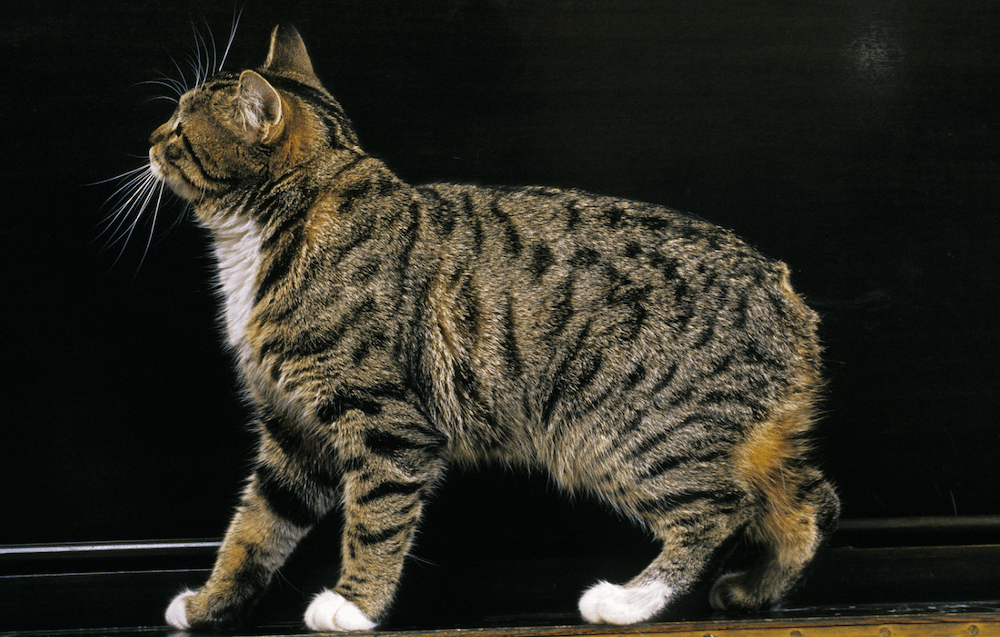
The short-haired Manx cat originated on the Isle of Man, a small island in an isolated area where inbreeding in the feline population gave rise to a lack of tail becoming a common trait.
While known for being a superior mouser, the Manx cat is also highly affectionate and mellow when not “on guard.” They are adaptable, intelligent, and people-oriented kitties that prefer the company of their family over just about anything.
Unfortunately, when two tailless cats mate, a collection of birth defects known as Manx Syndrome arises. In these cats, the spine and spinal cord are shortened, which leads to issues with the hind legs, urinary bladder, colon, and more. Ultimately it can result in the death of kittens or seriously compromised quality of life in cats that survive.
Cymric
Also having originated on the Isle of Man, the Cymric is considered the long-haired version of the Manx. Legend has it that the Cymric cat lost their tail when the door of Noah’s ark slammed shut on it. Ouch!
The Cymric is sweet and playful in personality just like the Manx, and sadly faces the same potentially fatal genetic abnormalities.
Photo credits:
- Cover: © TRUE KURILIANS / CC-BY-SA-4.0
- Highlander: © DigitalDirt / CC-BY-SA-4.0
- Pixie-bob: © Donna Cox / CC-BY-SA-3.0
- Kurilian Bobtail: © TRUE KURILIANS / CC-BY-SA-4.0
- Mekong Bobtail: © Alex Opryatin / CC-BY-SA-3.0
